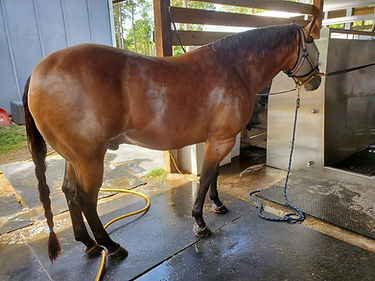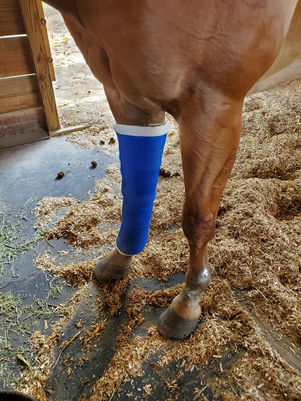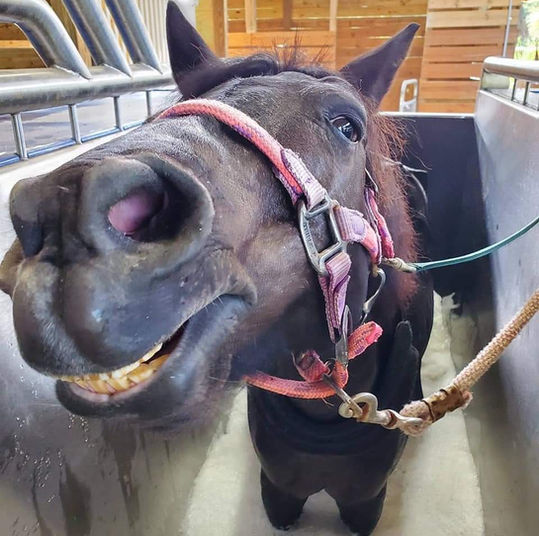
Exceptional Equine Retirement
Why Choose Equi-Fit?
We are one out of only a few equine rehabilitation facilities in Florida with a Cold Salt Water Therapy Spa, offering rehabilitation and customized equine services.
-
Equine Rehabilitation & Wellness Services
-
Customized Retirement Boarding Services
-
Personalized Care & Attention
-
Over 30 Years Combined Equine Experience


Why Hydrotherapy?
A veterinary perspective
To properly understand how the low temperature hydrotherapy of Equine Spas works we need to
review how the body reacts to the trauma of strains, cuts and bruises. When soft tissue is injured through a cut, tear or by concussive trauma the body releases enzymes and proteins causing the blood vessel walls in that vicinity to dilate and become more porous.
Lymphocytes are directed to the site of the trauma passing through the porous membranes and entering the injured tissues to begin fighting the infection. The extra fluids, carrying the oxygen and proteins for tissue repair, pool around the injured area causing edema or swelling which helps to immobilize the injury. Tissue damage also triggers the secretion of hormones which cause much of the pain the horse feels in order to prevent overuse of the affected limb. Additionally, the increased blood flow to the site of the injury results in a rise in temperature
in the tissues in that vicinity.

The three main symptoms of inflammation, namely pain, heat, and swelling, occur in varying degrees depending on the site, nature, and severity of the injury. The downside of inflammation is that it may rage out of control and hinder the healing process resulting in secondary tissue damage or hypoxic injury, which can compound the problem. In addition, blood vessels in the area are put under increasing pressure by the fluid build-up, thereby slowing down the flow of blood and lymphatic fluid.
The safest way to break the destructive cycle of secondary cell injury and excess swelling is to use the horse’s circulatory system to sweep away excess fluids that have collected in the tissues. While anti-inflammatory agents such as bute reduce swelling and heat, they may also mask pain confusing the diagnostic picture. Also, the use of corticosteroids to control heat and inflammation may have the disadvantage of shutting down the whole healing process.

How It Works
Equine Spa hydrotherapy relies on the following four basic factors:
1. Temperature
The application of cold triggers three basic reactions. Firstly, at a cellular level, the metabolic response of the cells is reduced, so the cells need less oxygen to function and thereby suffer less hypoxic injury. Secondly, the permeability of the blood vessel walls is decreased, thus reducing the amount of fluid that accumulates in the injured area. And
thirdly, the cold numbs the area to a certain degree, acting as a topical analgesic.
One of the best things about cold is that it does not override the beneficial effects of the healing
process. Please note that the application of cold should not be overdone. The overuse of ice, for
example, can cause tissue damage.
2. Salt Concentration
The salt concentration of the water has an impact on the healing process. Higher salt concentrations will draw away more of the fluids that accumulate around an injury. Additionally, the proportion of various salts has been found to allow injuries to heal more quickly.
3. Depth of Water
The greater the depth of the water, the greater the physical pressure exerted on the tissues. This,again, aids the dispersal of accumulated fluids.
4. Aeration
Aeration of the water has a two fold effect: it increases the dissolved oxygen level of the water and subjects the soft tissue to a gentle massaging action. It is thought that the increased oxygen level aids the healing process much as hyperbaric chambers do for humans, while the massage effect influences dispersal of fluids. In addition, horses tend to relax more than in still cold water as is evidenced by reduced heart rates.

What It Treats
Low temperature hydrotherapy can be used to treat a variety of leg issues by removing painful inflammation and fluid at the root of the problem and repairing tissue quickly.
The following conditions typically respond well to hydrotherapy treatment:
Joint Conditions
Laminitis
Brittle Hooves
Sore Shins
Ligament Injuries
Tendonitis
Hoove Injuries
Windgalls
Soft Tissue Injuries
Abscesses
Shin Splints
Pre & Post Competition
The Gallery








